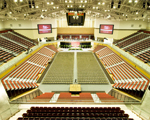In the days of the ancient Romans, crowds would gather by the thousands in the amphitheater to see a wide range of events: public ceremonies honoring brave soldiers, performances of dramatic presentations, or the gruesome games of the gladiators. Although the events were a visual extravaganza, the amphitheater and coliseum were also designed acoustically to allow the entire audience to hear. Fast forward two thousand years, and we still gather in large groups to see college graduations, rock concerts, sporting events, and more. Two of the primary senses that are titillating to the large masses still remain the same: visual and aural stimulation.
The modern design of arenas and amphitheaters must be done very carefully, or large groups of people will miss out on the full experience. We regularly design large video screens to provide image magnification (IMAG) of the action on the floor, and we design concert ready audio systems to amplify the sound on the stage. But the acoustical design of the facility goes even further beyond these details.
The overall reverberation time of the space must be designed so that it is not too lively (or the speech intelligibility of the audio system will be incomprehensible) or too dead (or the shouts and screams of the audience will be barely audible). Also, just like the walls of the ancient amphitheater were built up to block out sounds from the adjacent streets and city markets, the roar of the mechanical systems with large airflows must be blocked to minimize disturbances to the paying public.
At Acoustics By Design, we take a comprehensive look at the acoustical and audio-visual design of large arenas, such as our work at the Calvin College Spoelhof Fieldhouse Complex, and we work hard to balance the room acoustics and the background noise levels from the mechanical system to create a sonically pleasing environment that optimizes public gatherings for ceremonies, performances, and extravagant spectacles.

Great article Kenric! I like the way that you have synthesized the key arena acoustics issues into a brief and focused presentation. Another area of concern which could arise is the potential impact that an arena may have on the surrounding community, and the methods of containing the entertainment within, to maximize the enjoyment of the patrons and minimize the disturbance to others.
Very Interesting. Thanks
Bennett,
Thanks for the comments. You are correct that noise into the surrounding community can certainly be an issue. We have worked on projects where a stretch roof (with very little transmission loss) can result in crowd noise emanating out into the community. In addition, arenas have very large mechanical systems that can result in a lot of community noise issues. All of these considerations do need to be taken into account.
Kenric